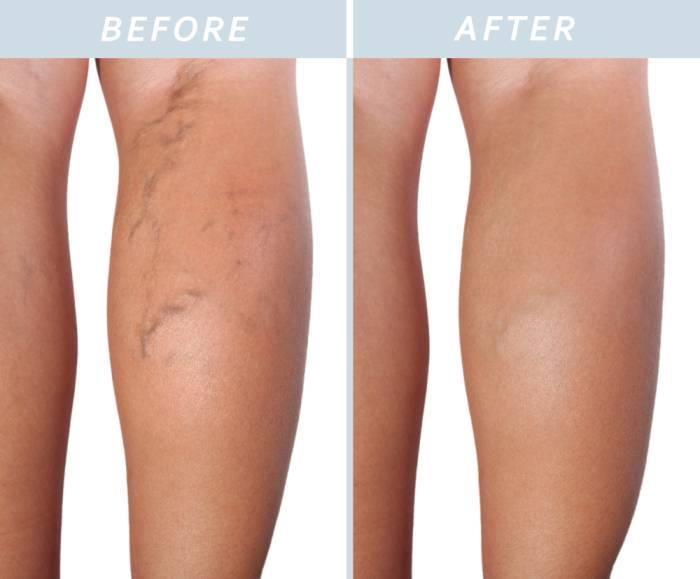Varicose Veins Treatment - Risks and Side Effects

A varicose vein is a painful medical condition in which veins on the legs, both calves and thighs become swollen and bulge. Varicose veins are not a life-threatening condition, but they can be uncomfortable and can cause excruciating pain. They often get sore and red and become inflamed. Doctors recommend surgery if the skin covering the varicose veins appears inflamed.
Treatment for varicose veins entailing surgery is not bereft of risks and side effects. Varicose vein treatment includes endovenous laser surgery, a procedure in which lasers are used to reduce varicose veins. Risks and Side Effects of Varicose Veins Treatment

A laser is an apparatus that ejects a laser beam, a form of radiation that produces heat and helps in the reduction of the size of the varicose veins. Laser varicose vein surgery is a minimally invasive procedure. It shrinks and closes varicose veins and creates scar tissues within the vessels, thereby sealing the vein. This obstructs the route the blood takes to flow through the body. With the vein blocked by scar tissues, the blood redirects to closeby veins.
Laser surgery is considered safe, but then all surgeries pose some risk. Remember, risks vary from person to person and can be dependent on overall physical health. The most common risks and side-effects associated with endovenous laser varicose surgery are:
ClariVein treatment is another procedure used to treat varicose veins. It is also known as mechanochemical ablation. This procedure involves the use of a catheter along with chemical and mechanical methods to treat, among other things, varicose veins. Radiofrequency is also used for treating varicose veins.
All treatments carry risks and have side-effects, and the most severe risk involved in the treatment of varicose veins, using radiofrequency ablation or ClariVein is the formation of blood clots, in the veins. This can lead to complications, especially when the clots move and get into the veins of the lungs. The blood clots in the lung veins can cause severe medical conditions, such as pulmonary embolism, which causes blockage of the pulmonary arteries in the lungs. The blood clots can also cause deep venous thrombosis, which is a severe medical condition, in which the clot moves into a vein somewhere deep within the body.
However, the risk of this happening is negligible, as doctors now use ultrasound during the procedure, and this ensures that the surgery is carried out without errors.
Though post-treatment recovery is quick patients may experience the following side-effects:
Doctors also suggest that patients wear compression stockings for a couple of weeks, after the treatment. This hastens the recovery and healing process. Patients are also advised to do leg elevation, as often as possible, to prevent complications and to avoid a recurrence of varicose veins.
Doctors ask patients to resume physical activity soon after the Clarivein and radiofrequency treatments. Physical activity helps in recovery and getting back to everyday life. However, patients should not go overboard with physical activity. They must take it easy and increase activity gradually. For instance, standing for long durations should be avoided, as it puts pressure on the veins. Alternative treatments for varicose veins

Alternative treatment for varicose veins is often useful in reducing appearance and pain caused by varicose veins. You can safely use these treatments, without fear of risks and side-effects and find relief. 1. Dietary changes
Foods have immense healing power. Change the way you eat, and you will find food working as medicine. Avoid sodium-rich foods as they cause the body to retain water. Cut down on excessive salt, and it will reduce water retention. Include potassium-rich foods in your diet, as they decrease water retention.
High potassium foods include:
>Nuts, such as pistachio, walnuts, pecan nuts, and almonds
>Fruits like bananas, avocados, and cantaloupe, and dates
>Vegetables rich in potassium include potatoes, sweet potatoes, spinach, mushroom, cucumber, and broccoli
>Lentils and beans
>Fish, particularly tuna and salmon
Have a fiber-rich diet. Plant-based, unprocessed foods are high in fiber. Keep the peels on the fruits and vegetables wherever possible, as they are packed with nutrients and are high in fiber. Eating more fiber prevents constipation, which stops you from straining while passing stools and damaging valves. 2. Herbal supplements
Consuming grape seed extract is said to bring down the swelling in the legs and reduce some persistent symptoms associated with varicose veins. A few other herbal extracts known to minimise varicose veins symptoms are:
Consult with your doctor before taking herbal extracts, especially if you are on blood-thinning medication. 3. Exercise
Exercise is good for overall health. Patients suffering from varicose veins must follow a regular exercise routine. Exercise improves blood circulation in the legs, and this, in turn, moves the blood accumulated in the veins. Exercise also causes weight loss, which reduces the pressure on the legs.
Avoid strenuous exercise routines and instead, do low-impact exercises. The best exercise forms to include in your daily regime are cycling, swimming, walking, and yoga.4. Chelation Therapy
Chelation Therapy is one of the latest treatments to be introduced for the treatment of varicose veins. Chelation Therapy is a non-invasive procedure and comparatively cheaper than the other medical treatments for varicose veins. It is a safe and effective procedure.
The therapy is used for treating various illnesses, including varicose veins. The simple procedure uses a prescription drug, known as Ethylene Diamine Tetra Acetic Acid (EDTA). The drug is given intravenously. It restores blood flow and prevents varicose veins. 5. Ayurvedic treatment for varicose veins
Ayurvedic treatment for varicose veins involves Abhyanga, a traditional massage using herbal oils and gentle massage and pressure on the pressure points. The procedure enhances the internal balance and accelerates blood flow, and decreases symptoms of varicose veins.
